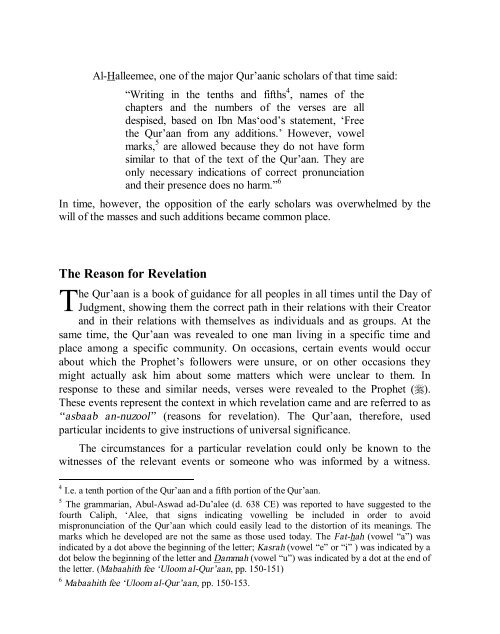You also want an ePaper? Increase the reach of your titles
YUMPU automatically turns print PDFs into web optimized ePapers that Google loves.
Al-Halleemee, one of the major Qur’aanic scholars of that time said:<br />
“Writing in the tenths and fifths 4 , names of the<br />
chapters and the numbers of the verses are all<br />
despised, based on Ibn Mas‘ood’s statement, ‘Free<br />
the Qur’aan from any additions.’ However, vowel<br />
marks, 5 are allowed because they do not have form<br />
similar to that of the text of the Qur’aan. They are<br />
only necessary indications of correct pronunciation<br />
and their presence does no harm.” 6<br />
In time, however, the opposition of the early scholars was overwhelmed <strong>by</strong> the<br />
will of the masses and such additions became common place.<br />
The Reason for Revelation<br />
T<br />
he Qur’aan is a book of guidance for all peoples in all times until the Day of<br />
Judgment, showing them the correct path in their relations with their Creator<br />
and in their relations with themselves as individuals and as groups. At the<br />
same time, the Qur’aan was revealed to one man living in a specific time and<br />
place among a specific community. On occasions, certain events would occur<br />
about which the Prophet’s followers were unsure, or on other occasions they<br />
might actually ask him about some matters which were unclear to them. In<br />
response to these and similar needs, verses were revealed to the Prophet (r).<br />
These events represent the context in which revelation came and are referred to as<br />
“asbaab an-nuzool” (reasons for revelation). The Qur’aan, therefore, used<br />
particular incidents to give instructions of universal significance.<br />
The circumstances for a particular revelation could only be known to the<br />
witnesses of the relevant events or someone who was informed <strong>by</strong> a witness.<br />
4 I.e. a tenth portion of the Qur’aan and a fifth portion of the Qur’aan.<br />
5 The grammarian, Abul-Aswad ad-Du’alee (d. 638 CE) was reported to have suggested to the<br />
fourth Caliph, ‘Alee, that signs indicating vowelling be included in order to avoid<br />
mispronunciation of the Qur’aan which could easily lead to the distortion of its meanings. The<br />
marks which he developed are not the same as those used today. The Fat-hah (vowel “a”) was<br />
indicated <strong>by</strong> a dot above the beginning of the letter; Kasrah (vowel “e” or “i” ) was indicated <strong>by</strong> a<br />
dot below the beginning of the letter and Dammah (vowel “u”) was indicated <strong>by</strong> a dot at the end of<br />
the letter. (Mabaahith fee ‘Uloom al-Qur’aan, pp. 150-151)<br />
6 Mabaahith fee ‘Uloom al-Qur’aan, pp. 150-153.














